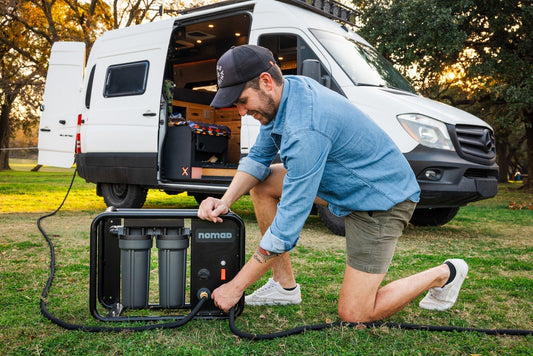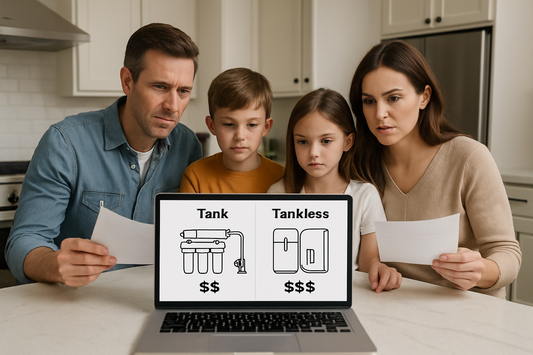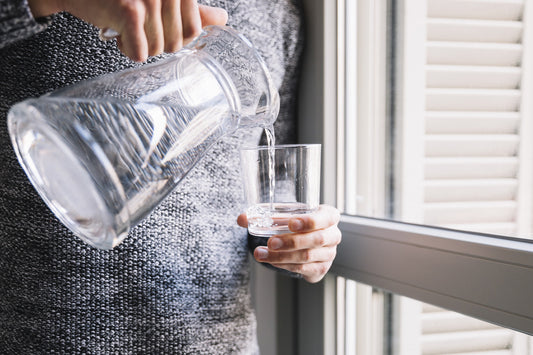Best Countertop Water Filter: Your Complete 2025 Buyer's Guide
Clean, safe drinking water shouldn't be a luxury—it should be accessible to every household. If you're tired of expensive bottled water or concerned about what's flowing from your tap, a countertop water filter offers the perfect solution. These compact systems deliver professional-grade filtration without the need for permanent installation or plumbing modifications.
Whether you're a renter who can't modify your kitchen, a homeowner seeking an affordable water solution, or simply someone who values convenience and health, finding the best countertop water filter can transform your daily hydration experience while protecting your family's well-being.
Why Countertop Water Filters Are Taking Over American Kitchens
The surge in countertop filter popularity isn't just a trend—it's a practical response to growing water quality concerns and changing lifestyles. Unlike under-sink systems that require installation or whole-house units that demand significant investment, countertop filters deliver immediate results with minimal setup.
Recent studies show that over 85% of American households have detectable levels of contaminants in their tap water, including chlorine, lead, pesticides, and pharmaceutical residues. For busy families and health-conscious individuals, countertop water filters provide peace of mind without the complexity or cost of major water treatment systems.
Understanding Countertop Water Filter Benefits

Image by Teksomolika
Immediate Health Protection
The primary advantage of any quality countertop system lies in its ability to remove harmful contaminants while preserving beneficial minerals. Modern systems target chlorine, lead, mercury, pesticides, and volatile organic compounds (VOCs) that municipal treatment may miss.
Economic Advantages
Consider this: the average American family spends over $1,200 annually on bottled water. A quality countertop filter pays for itself within 3-4 months while providing superior filtration compared to most bottled water brands.
Environmental Impact
By choosing filtered tap water over bottled alternatives, you're preventing hundreds of plastic bottles from entering landfills and oceans. This simple switch can eliminate your family's contribution to the 60 million plastic bottles discarded daily in America.
Convenience Factor
No scheduling installations, no crawling under sinks, no modifying your rental agreement. Countertop filters work immediately and move with you when life changes.
What Makes the Best Countertop Water Filter Stand Out

Image by Macrovector
Multi-Stage Filtration Technology
Top-performing systems utilize multiple filtration stages to address different contaminant categories:
Stage 1: Sediment Removal - Captures visible particles, rust, and debris that affect water clarity and taste.
Stage 2: Chemical Absorption - Advanced carbon filtration removes chlorine, industrial chemicals, and organic compounds that create unpleasant odors and tastes.
Stage 3: Heavy Metal Reduction - Specialized media targets lead, mercury, and other toxic metals that pose serious health risks.
Flow Rate Performance
The best systems balance thorough filtration with practical flow rates. Look for units producing 0.5-1.0 gallons per minute—fast enough for cooking and drinking needs without compromising filtration effectiveness.
Filter Lifespan and Replacement Costs
Quality systems feature long-lasting filters (6-12 months) with reasonable replacement costs. Calculate the total cost of ownership, not just the initial purchase price.
Top Countertop Water Filter Categories Explained
Gravity-Fed Systems
These systems rely on gravity to pull water through filtration media. They're typically more affordable and don't require electricity, making them perfect for emergency preparedness or areas with unreliable power.
Direct-Connect Faucet Systems
These units attach directly to your existing faucet, offering convenient switching between filtered and unfiltered water. They provide faster flow rates and often feature more advanced filtration technology.
Internal Link Opportunity: For households needing whole-home protection, explore our complete water filtration systems that address water quality at every tap.
Reverse Osmosis Countertop Units
Though technically countertop systems, RO units provide the most comprehensive filtration available. They remove virtually all contaminants but require proper maintenance and produce some wastewater.
Key Features to Consider When Choosing Your System
Contaminant Removal Capabilities
Review your local water quality report (available from your utility company) to understand what contaminants you're targeting. The best countertop water filter for your situation addresses your specific water quality challenges.
Certification Standards
Look for systems certified by NSF International or the Water Quality Association (WQA). These third-party certifications verify that systems actually remove the contaminants they claim to address.
Installation Requirements
Consider your kitchen setup and technical comfort level. Some systems require simple faucet attachment, while others need minimal assembly but no permanent modifications.
Maintenance Schedule
Factor in filter replacement frequency and availability. Systems requiring frequent replacements or expensive proprietary filters may cost more long-term despite lower initial prices.
Crystal Quest vs. Waterdrop: Leading Brands Compared

Crystal Quest Countertop Systems
Crystal Quest has built a reputation for robust, multi-stage filtration systems that excel in heavy-use households. Their countertop units typically feature:
- Multi-stage filtration combining sediment, carbon, and specialty media
- Higher flow rates suitable for families
- Durable construction designed for daily use
- Comprehensive contaminant removal including heavy metals and chemicals
These systems work exceptionally well for families prioritizing maximum contaminant removal and don't mind slightly larger footprints.
Waterdrop Countertop Options
Waterdrop focuses on reverse osmosis, sleek design and user-friendly operation, making their systems popular among first-time filter buyers and design-conscious households. Key advantages include:
- Compact, modern designs that complement contemporary kitchens
- Easy installation and maintenance procedures
- Advanced filtration technology in space-efficient packages
- Excellent customer support and readily available replacement filters
Waterdrop systems excel for individuals and smaller households wanting effective filtration without dominating counter space.
Installation Made Simple: Getting Started

Image by freepik
Pre-Installation Preparation
Clear your intended installation area and gather basic tools if required. Most systems need only hand-tightening, though some benefit from having an adjustable wrench available for secure connections.
Step-by-Step Setup Process
- Unpack and inspect all components, ensuring nothing was damaged during shipping
- Install filtration cartridges according to manufacturer specifications—this usually involves removing housing caps and inserting filters
- Connect to water source whether that's direct faucet attachment or filling a gravity-fed reservoir
- Prime the system by running water through for the recommended time to remove any manufacturing residues
- Test water flow and check all connections for leaks before regular use
Initial Flush and Quality Check
Always flush new systems according to manufacturer guidelines. This removes carbon fines and manufacturing residues, ensuring your first glass of filtered water meets quality expectations.
Maximizing Your Investment: Maintenance and Troubleshooting
Filter Replacement Schedule
Mark your calendar for filter replacements based on manufacturer recommendations and your household usage. Most families benefit from setting quarterly reminders to check filter condition and water taste quality.
Common Issues and Solutions
Reduced flow rate typically indicates filter saturation—time for replacement or cleaning if your system allows it.
Unusual taste or odor suggests filters have reached capacity or contaminants are breaking through—replace immediately.
Leaking connections usually require checking O-rings and connection tightness—most issues resolve with gentle adjustment.
Performance Optimization Tips
Monitor your local water quality reports for seasonal changes that might affect filter performance. Some areas experience higher contaminant levels during agricultural seasons or after heavy rainfall.
Making the Smart Choice for Your Family
The best countertop water filter for your household depends on your specific needs, water quality challenges, and lifestyle preferences. Consider these final factors:
Budget vs. Features: Higher-priced systems often provide better long-term value through longer filter life and superior contaminant removal.
Space Constraints: Measure your available counter space and consider how the system will integrate with your daily kitchen activities.
Family Size: Larger households benefit from higher-capacity systems with faster flow rates and longer-lasting filters.
Water Quality Goals: If you're primarily addressing taste and odor, basic carbon systems work well. For comprehensive contaminant removal, invest in multi-stage systems.
Your Path to Better Water Starts Today
Choosing a countertop water filter represents more than just improving your water's taste—it's an investment in your family's health, environmental responsibility, and long-term savings. Whether you select a robust Crystal Quest system for maximum filtration or a sleek Waterdrop unit for convenience and style, you're taking a meaningful step toward better hydration and peace of mind.
The countertop water filter benefits extend far beyond the initial purchase. You'll enjoy cleaner-tasting water, reduced plastic waste, significant savings over bottled water, and the confidence that comes from knowing exactly what's in every glass you drink.
Start your journey to better water today, and experience the difference that quality filtration makes in your daily life.





